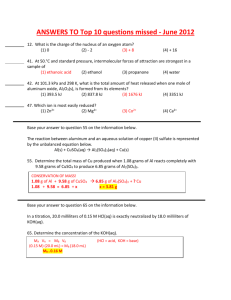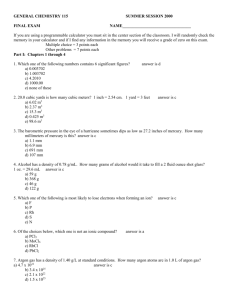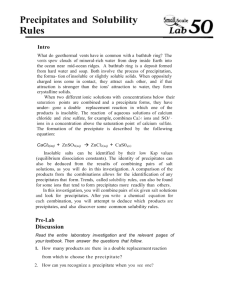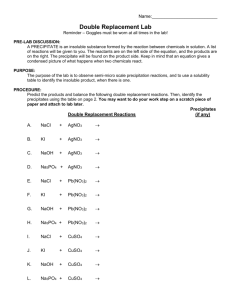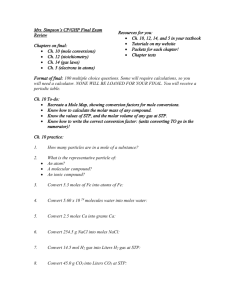Double Replacement Reactions
advertisement
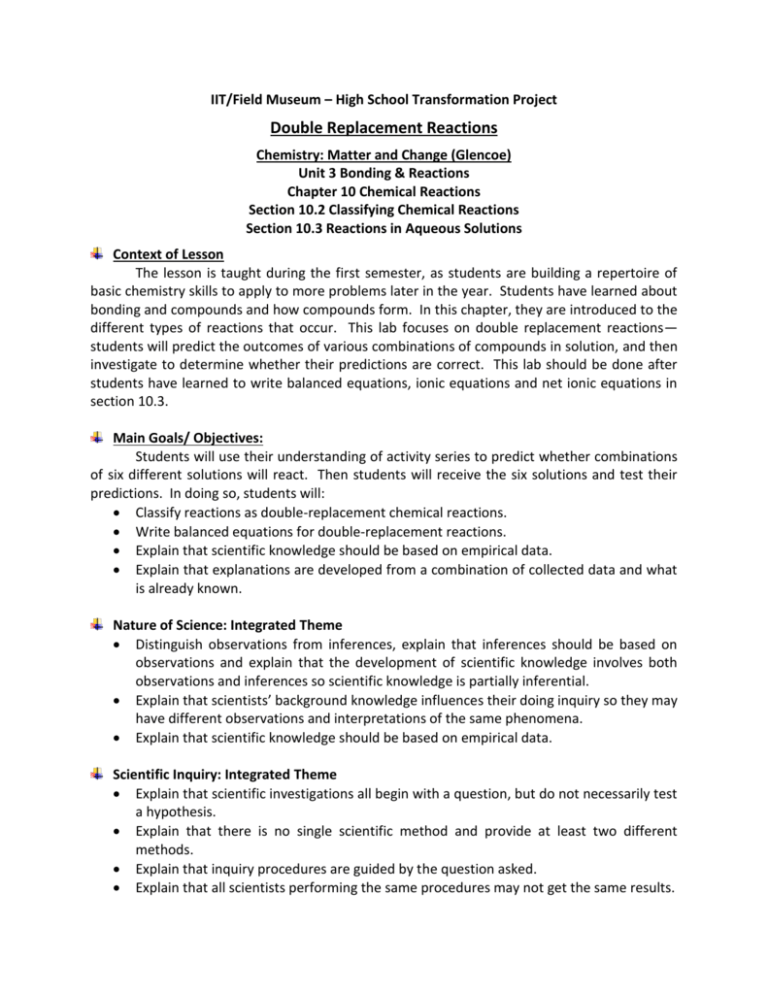
IIT/Field Museum – High School Transformation Project Double Replacement Reactions Chemistry: Matter and Change (Glencoe) Unit 3 Bonding & Reactions Chapter 10 Chemical Reactions Section 10.2 Classifying Chemical Reactions Section 10.3 Reactions in Aqueous Solutions Context of Lesson The lesson is taught during the first semester, as students are building a repertoire of basic chemistry skills to apply to more problems later in the year. Students have learned about bonding and compounds and how compounds form. In this chapter, they are introduced to the different types of reactions that occur. This lab focuses on double replacement reactions— students will predict the outcomes of various combinations of compounds in solution, and then investigate to determine whether their predictions are correct. This lab should be done after students have learned to write balanced equations, ionic equations and net ionic equations in section 10.3. Main Goals/ Objectives: Students will use their understanding of activity series to predict whether combinations of six different solutions will react. Then students will receive the six solutions and test their predictions. In doing so, students will: Classify reactions as double-replacement chemical reactions. Write balanced equations for double-replacement reactions. Explain that scientific knowledge should be based on empirical data. Explain that explanations are developed from a combination of collected data and what is already known. Nature of Science: Integrated Theme Distinguish observations from inferences, explain that inferences should be based on observations and explain that the development of scientific knowledge involves both observations and inferences so scientific knowledge is partially inferential. Explain that scientists’ background knowledge influences their doing inquiry so they may have different observations and interpretations of the same phenomena. Explain that scientific knowledge should be based on empirical data. Scientific Inquiry: Integrated Theme Explain that scientific investigations all begin with a question, but do not necessarily test a hypothesis. Explain that there is no single scientific method and provide at least two different methods. Explain that inquiry procedures are guided by the question asked. Explain that all scientists performing the same procedures may not get the same results. Explain that inquiry procedures can influence the results of an investigation. Explain that research conclusions must be consistent with the data collected. Explain that scientific data are not the same as scientific evidence. Explain that explanations are developed from a combination of collected data and what is already known. General Alignment to Standards State Goal 11: Understand the processes of scientific inquiry and technological design to investigate questions, conduct experiments and solve problems. A. Know and apply the concepts, principles and processes of scientific inquiry. 11.A.4a Formulate hypothesis referencing prior research and knowledge 11.A.5b Design procedures to test the selected hypotheses. 11.A.4c Collect, organize and analyze data accurately and precisely 11.A.4e Formulate alternative hypotheses to explain unexpected results State Goal 12: Understand the fundamental concepts, principles and interconnections of the life, physical and earth/space sciences. C. Know and apply the concepts that describe properties of matter and energy and the interactions between them. 12.C.3b Model and describe the chemical and physical characteristics of matter. Materials Per student: Lab notebook Student lab sheet Safety Glasses Gloves Aprons For each group of 2 students Micro-well plate (24 wells) 6 dropper bottles or 6 beakers and 6 labeled pipettes (These may be shared by 2 or 3 lab groups working at the same table) Approx. 2 mL of each of the following solutions o 0.20 M aluminum sulfate (Al2(SO4)3) o 0.20 M magnesium chloride (MgCl2) o 0.20 M potassium hydroxide (KOH) o 0.20 M silver nitrate (AgNO3) o 0.20 M sodium carbonate (Na2CO3) o 0.20 M sodium chloride (NaCl) Supplies to be made available to all students/class Distilled water for rinsing well plates Cotton swabs for cleaning well plates Light and dark paper to hold beneath well plates Overhead transparency of solubility rules Safety Remind students that lab materials are to be used ONLY as directed Silver Nitrate will stain EVERYTHING! Be careful using this solution. If the silver nitrate solution gets on skin, wash immediately. Even so, there will be a brown/black stain on the skin for several days to a week. The silver nitrate must be collected in a waste container. There are two safe means of disposal. 1. Add excess salt (sodium chloride, NaCl) to the solution and mix well. This will convert the silver nitrate into silver chloride which is insoluble in water and will constrain the heavy metal from leaching into the landfill soil as a toxin. The mixture can be put in the trashcan as the silver chloride form. 2. Some teachers prefer to keep the silver. Wrap a copper wire around a pencil, and then pull the wire off to produce a tight coil of wire. Submerge the coiled wire in the silver nitrate waste solution. The silver will precipitate onto the copper wire via a single replacement reaction. The silver should be rinsed with water before and after removing it from the copper coil. Put the copper coil back in the solution and repeat until no more silver is readily obtained. Preparation To prepare 150 mL of each 0.20M solution, dissolve the amount of compound listed below in enough distilled water to make 150 mL of solution. Al2(SO4)3…...dissolve 10.26g MgCl2………..dissolve 2.86g KOH…………..dissolve 1.68g AgNO3……....dissolve 5.10g Na2CO3……...dissolve 3.18g NaCl……….….dissolve 1.75g Place the solutions in labeled dropper bottles (at least 3 bottles of each solution, distributed around the lab) or in labeled beakers. If using beakers, then label dropper pipettes (one pipette per solution, per lab group) by wrapping masking tape or labeling tape around the neck of the pipette to make a flag. Write the solution’s formula on the flag with permanent marker. This is to prevent cross-contamination of solutions. Dropper bottles reduce the risk of cross-contamination. The Lesson Bell Ringer Before students arrive, write on the board or overhead: “You can recognize single replacement reactions because they always involve one compound and one element on each side. What are clues for recognizing the other four reaction types? Write your ideas.” Give students a moment to answer, and then allow them to share their ideas with a partner. Activity Begin lesson by reviewing with students the fact that double replacement reactions always occur in solution. Remind them that, just like in the single replacement lab, not every combination of reactants will result in a reaction. Review the dissolving process for ionic compounds and ask students: If both reactants and both replacement products are all soluble, what happens when they are mixed? Unless a product leaves solution—generally as a precipitate, gas, or water—no reaction occurs. Optional – Honors Classes Discuss with you students how reactivity and solubility will affect the outcome of a reaction. Because the reactions depend, therefore, on whether the potential products are soluble, we can use solubility rules to predict the outcome of combining two solutions. Demonstrate the correct use of the solubility rules by doing a couple of examples: Sodium carbonate is soluble because of rule #1: salts of alkali metals are soluble. Note that, because of the wording of rule #5, rule #1 “trumps” (overrules) it, and sodium carbonate is soluble. Aluminum hydroxide is not soluble because of rule #5. Lead (II) chloride is not soluble because of rule #4. Distribute the lab sheets and allow students a few moments to read them. Tell students they must predict whether each combination of solutions will result in a reaction, then perform the combination to see if they are correct. Their conclusions must agree with the empirical data available—their observations in lab and their understanding of activity series. Review for students the relevant lab safety measures—they must wear goggles, avoid getting any solutions on their skin or clothing, clean up spills immediately, read labels carefully, follow directions for disposal, and wash their hands after the lab. Call students’ attention to the special treatment required for silver compounds: they should do all of their tests with the silver nitrate solution first, then pour the contents of their well plates into the special silver collection beaker before continuing with the tests that do not use silver. Also, remind students that bases such as KOH are corrosive and should be rinsed off immediately if they contact the skin. Divide students into pairs and allow them to do the lab activity. Move among students as they work, observing their procedures, lab techniques, observations and answers. As necessary, pose questions to make students observe more carefully or think more deeply about what they are observing. Ask questions such as, “What’s going on in this well? Why?” Make sure to interact with each group at least once or twice during the lab. Be alert for students who are not following the safety guidelines and remind all students to dispose of their chemical wastes correctly. When most students have completed the lab and cleaned up their work areas, gather the class back at their desks. Review students’ observations and discuss their conclusions. Discuss possible sources of error. Ask students whether their conclusions come entirely from their observations in lab, entirely from prior knowledge or from a combination. Ask what challenges students encountered as they performed the lab and allow students to comment on one another’s conclusions and challenges. Homework Finish the discussion part of the lab—write equations for the reactions observed and answer the questions. Modifications/Accommodations To free up more time for the lab activity, talk briefly about solubility rules the day before the lab and assign the predictions table for homework. Then on lab day, students may begin testing their combinations immediately. To make the lab more challenging, do not provide students with pre-constructed data tables; rather, require them to make their own data tables. Assessment Students’ achievement of the objectives will be assessed by observing their work in lab, their answers to the lab questions, their answers to questions during the discussion after lab and their work on test questions about double replacement reactions. Double Replacement Reaction Laboratory Investigation When ionic compounds dissolve in water, the ions in the crystal separate and move throughout the solution. When two such solutions are mixed, all types of positive ions in the new solution are attracted to all types of negative ions in the solution. Sometimes a reaction takes place. This reaction is called a double-replacement reaction. All double replacement reactions produce water, a precipitate or a gas. In this type of reaction, the ions of two compounds change places. Such a reaction is usually shown as: AB (aq) + CD (aq) AD (aq) + CB (aq) AB (aq) + CD (aq) AD (aq) + CB (S) AB (aq) + CD (aq) AD (aq) + CB (g) As the solutions are mixed, positive A and C ions exist in solution, as do negative B and D ions, and these oppositely charged ions attract each other. A reaction takes place if a compound that forms removes ions from solution. In this lab, you will use the solubility rules to predict whether a reaction will occur when two solutions are mixed. Then you will mix the solutions to see if your predictions are accurate. Because you will be working with acid and other solutions (notably silver nitrate, which can cause skin burns with a single drop), you must wear lab goggles and follow the lab safety guidelines very carefully. Pre-lab: 1. Read the procedure. 2. On the predictions table, fill in which ions are present in each solution. Two examples are done for you. 3. Each box in the predictions table represents a combination of two solutions. For example, the first blank box represents the combination of AgNO3 solution and NaCl solution. Use the charges on the ions to predict the formulas of the possible products. One example is done for you. Precautions: 1. Use special care when handling the AgNO3 solution. It can stain skin and clothing. If you do get some on yourself, rinse the affected area with LOTS of water. 2. Use care also when handling the KOH solution. It is a base and can burn your skin. If you do get some on yourself, rinse with lots of water—until the slippery feeling goes away. Double Replacement Reaction Laboratory Investigation Procedures Materials: 2 micro-well plates 5 Dropper pipets 5 drops of each the following solutions o 0.20 M aluminum sulfate (Al2(SO4)3) o 0.20 M magnesium chloride (MgCl2) o 0.20 M potassium hydroxide (KOH) o 0.20 M silver nitrate (AgNO3) o 0.20 M sodium carbonate (Na2CO3) o 0.20 M sodium chloride (NaCl) Procedures: Place the two (2) micro-well plates on top of a NaCl Na2CO3 MgCl2 KOH Al2(SO4)3 Na2CO3 MgCl2 KOH Al2(SO4)3 NaCl Na2CO3 MgCl2 KOH Al2(SO4)3 white piece of paper and label each row AgNO3 and column as shown in the example provided above. Add five (5) drops of Al2(SO4)3, MgCl2, KOH, Na2CO3, and NaCl to the appropriate wells down each column. Be very careful not to mix up the pipettes, or the solutions will become contaminated and you will not know what is or is not reacting! Add five (5) drops of Al2(SO4)3, KOH, Na2CO3, NaCl, and AgNO3 to the appropriate wells across each row. Be very careful not to mix up the pipettes, or the solutions will become contaminated and you will not know what is or is not reacting! Test all combinations with silver nitrate and observe the results. Move the well plate over light and dark surfaces to make different precipitates visible. Record your observations. Then pour all mixtures containing silver ions into the silver waste container. Clean the well plate. Observe and record any indication of a chemical reaction (precipitate is produced or gas is released). Clean up: Pour all of the solutions containing SILVER ions into the beaker labeled “Waste AgNO3”. Rinse all other combinations NOT containing silver ions down the drain with plenty of water. Any remaining solutions may be rinsed down the drain with plenty of water. Write up: For each combination that produced a precipitate or a gas, write the balanced equation. Be sure that you have written the correct formula for each of the compounds formed in the reactions. Then balance the equation. Double Replacement Reaction Laboratory Investigation Data Tables Name: _________________________ ____________________________ Period: __________ Prediction Data Table NaCl Na2CO3 ____ & ____ Na+ & CO32- MgCl2 KOH Al2(SO4)3 ____ & ____ ____ & ____ ____ & ____ Na2CO3 ____ & ____ MgCl2 ____ & ____ KOH ____ & ____ Al2(SO4)3 ____ & ____ AgNO3 Ag+ & NO3- NaNO3 Ag2CO3 Record your observations on the table below. Write “NR” if no reaction is observed and “PPT” if a precipitate is produced (note a brief description if you notice a reaction). Double Replacement Data Table NaCl Na2CO3 MgCl2 KOH Al2(SO4)3 AgNO3 Na2CO3 MgCl2 KOH Al2(SO4)3 Double Replacement Reaction Laboratory Investigation Data Tables Prediction Data Table NaCl Na+ & Cl- Na2CO3 Na+ & CO32- MgCl2 Mg2+ & Cl- KOH K+ & OH- Na2CO3 Na+ & CO32- NR MgCl2 Mg2+ & Cl- MgCl2 NaCl MgCO3 NaCl KOH K+ & OH- KCl NaOH K2CO3 NaOH KCl Mg(OH)2 Al2(SO4)3 Al3+ & SO42- AlCl3 Na2SO4 Al2(CO3)3 Na2SO4 AlCl3 MgSO4 Al(OH)3 KSO4 AgNO3 Ag+ & NO3- AgCl NaNO3 AgCO3 NaNO3 AgCl Mg(NO3)2 AgOH KNO3 Al2(SO4)3 Al3+ & SO42- Ag2SO4 Al(NO3) Record your observations on the table below. Write “NR” if no reaction is observed and “PPT” if a precipitate is produced (note a brief description if you notice a reaction). Double Replacement Data Table NaCl Na2CO3 MgCl2 KOH Na2CO3 NR MgCl2 NR PPT KOH NR NR PPT Al2(SO4)3 NR PPT NR PPT AgNO3 PPT PPT PPT PPT Al2(SO4)3 PPT Discussion: 1. Write the balanced equation for the reactions that produced a precipitate (label the precipitate with (s)). Be sure to verify that you have the correct formula for each compound before you balance the equation! 2. Choose two of the equations from Question 1 and rewrite them as ionic and net ionic equations. 3. Identify any cases where your data was different from your predictions. Offer explanations of possible sources of error. 4. Using your understanding of activity series, write down the equation for two reactions that took place but did not produce an observable reaction. Discussion: 1. Write the balanced equation for each of the expected reactions. Label the expected precipitate with (s). (Be sure to verify that you have the correct formula for each compound before you balance the equation!) NaCl (aq) + AgNO3 (aq) NaNO3 (aq) + AgCl (s) Na2CO3 (aq) + 2 AgNO3 (aq) 2 NaNO3 (aq) + Ag2CO3 (s) MgCl2 (aq) + 2 AgNO3 (aq) Mg(NO3)2 (aq) + 2 AgCl (s) KOH (aq) + AgNO3 (aq) KNO3 (aq) + AgOH (s) Al2(SO4)3 (aq) + 6 AgNO3 (aq) 2 Al(NO3)3 (aq) + 3 Ag2SO4 (s) Al2(SO4)3 (aq) + 3 Na2CO3 (aq) Al2(CO3)3 (s) + 3 Na2SO4 (aq) Al2(SO4)3 (aq) + 6 KOH (aq) 2 Al(OH)3 (s) +3 K2SO4 (aq) MgCl2 (aq) + 2 KOH (aq) 2 KCl (aq) + Mg(OH)2 (s) Na2CO3 (aq) + MgCl2 (aq) 2 NaCl (aq) + MgCO3 (s) 2. Choose two of the equations from number 3 and rewrite them as ionic and net ionic equations. Answers will vary. An example: Ionic: Na+ (aq) + Cl- (aq) + Ag+ (aq) + NO3- (aq) Na+ (aq) + NO3- (aq) + AgCl (s) Net ionic: Ag+ (aq) + Cl- (aq) AgCl (s) 3. Identify any cases where your data was different from your predictions. Offer explanations of possible sources of error. Possible sources of error will vary but may include contamination of droppers or wells, using the wrong solution or not enough of it, and not waiting long enough to see a reaction. 4. Using your understanding of activity series, write down the equation for two reactions that took place but did not produce an observable reaction. Answers will vary. An example: NaCl (aq) + KOH (aq) NaOH (aq) + KCl (aq) Since sodium (Na) and potassium (K) are both alkali and alkali salts are soluble, they will not form a precipitate. A double replacement reaction takes place since the more reactive potassium (K) replaces the sodium (Na) to form potassium chloride (KCl) and the sodium bonds to the hydroxide to form sodium hydroxide (NaOH). Solubility Rules 1. Salts of alkali metals (group I) and ammonium are soluble, EXCEPT a few lithium compounds. 2. Nitrate and chlorate salts are soluble. 3. Sulfate salts are soluble. EXCEPT lead (Pb), silver (Ag), mercury (Hg), barium (Ba), strontium (Sr), and calcium (Ca). 4. Chloride salts are soluble. EXCEPT lead (Pb), silver (Ag), and mercury (Hg). 5. Carbonates, phosphates, chromates, sulfides, and hydroxides are insoluble unless they are listed as soluble above.
